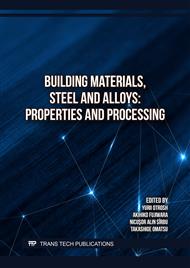[1]
Kostin, V., Poznyakov, V., Gayvoronskiy, A., Mossokovskaya, I., Zuber, T., Zhukov, V., & Kostin, Yu. (2015). The influence of electric arc welding modes on the nature of structural transformations in the metal of the zone of thermal impact of steel 30Х2Н2МФ. Shipbuilding and Maritime Infrastructure, (1), 87-102.
DOI: 10.15589/smi20150105
Google Scholar
[2]
Pozdnyakov, V.D. (2017). Welding technologies for production and repair of metal structures from high-strength steels. Bulletin of the National Academy of Sciences of Ukraine, 2017. (1), 65-73
Google Scholar
[3]
Sun, Y., Chen, P., & Zhao, C. (2025). Mechanism of material microstructure on the fragmentation results of explosively driven metal cylinders based on fracture modes. Journal of Materials Research and Technology, 130-139.
DOI: 10.1016/j.jmrt.2025.01.026
Google Scholar
[4]
Zaera, R., & Fernández-Sáez, J. (2007). Finite element simulation of steel ring fragmentation under radial expansion. International Journal of Impact Engineering, 34(3), 452-464.
DOI: 10.1016/j.ijimpeng.2006.01.003
Google Scholar
[5]
Gandra, J., Krohn, H., Miranda, R. M., Vilaça, P., Quintino, L., & dos Santos, J. F. (2013). Friction surfacing—a review. Journal of Materials Processing Technology, 214(5), 1062-1093.
DOI: 10.1016/j.jmatprotec.2013.12.008
Google Scholar
[6]
Solano-Alvarez, W., & Rivera-Díaz-del-Castillo, P. E. J. (2024). Steels for rails. Progress in Materials Science, 124, 100851.
Google Scholar
[7]
Vogler, T. J., & Clayton, J. D. (2016). New insights into the role of porous microstructure on dynamic shear localization. International Journal of Plasticity, 83, 1-20.
Google Scholar
[8]
Jones, S. E., & Birch, R. S. (2012). Spiral strand cables subjected to high velocity fragment impact. International Journal of Impact Engineering, 49, 1-12.
Google Scholar
[9]
Laukhin, D.V., Sukhomlin, G.D., Beketov, A.V., Ivantsov, S.V., Schudro, А.E., & Laukhin. V.D. The effect of temperature-deformation processing in the intercritical temperature range on the structure and properties of thick sheets of low-carbon building steels. Construction, materials science, mechanical engineering, (96), 95-102.
Google Scholar
[10]
Laukhin, D., Beketov, O., Rott, N., & Schudro, A. (2019). The Elaboration of Modernized Technology of Controlled Rolling Directed at the Formation of High Strengthening and Viscous Qualities in HSLA Steel. Solid State Phenomena, (291), 13-19.
DOI: 10.4028/www.scientific.net/ssp.291.13
Google Scholar
[11]
Ziborov K.A.; Protsiv V.V.; Blokhin S.Ye.; Fedoriachenko S.O. (2014), Applicability of computer simulation while designing mechanical systems of mining rolling stock, Naukovyi Visnyk Natsionalnoho Hirnychoho Universytetu, Vol. 6, pp.55-59.
Google Scholar
[12]
Danchenko, Y., Andronov, V., Barabash, E., Obigenko, T., Rybka, E., Meleshchenko, R., Romin, A. (2017). Research of the intramolecular interactions and structure in epoxyamine composites with dispersed oxides. Eastern-European Journal of Enterprise Technologies, 6/12 (90), 4-12.
DOI: 10.15587/1729-4061.2017.118565
Google Scholar
[13]
Laukhin D., Ziborov K., Rott N., Fedoriachenko S. (2024) Analysis of the Effects of Welding Conditions on the Microhardness of Low-Carbon Low-Alloy Steels, Materials Science Forum, 1126, p.119 – 127
DOI: 10.4028/p-lD0xWA
Google Scholar
[14]
Kovalov, A., Otrosh, Y., Rybka, E., Kovalevska, T., Togobytska, V., Rolin, I. (2020). Treatment of determination method for strength characteristics of reinforcing steel by using thread cutting method after temperature influenceTerms and conditions Privacy policy Copyright © 2021 Elsevier B.V. All rights reserved. Scopus® is a registered trademark of Elsevier B.V. (2020) Materials Science Forum, 1006 MSF, 179-184
DOI: 10.4028/www.scientific.net/MSF.1006.179
Google Scholar
[15]
Sokolov, D., Sobyna, V., Vambol, S., Vambol, V. (2018). Substantiation of the choice of the cutter material and method of its hardening, working under the action of friction and cyclic loading. Archives of Materials Science and Engineering, 94/2, 49-54
DOI: 10.5604/01.3001.0012.8658
Google Scholar
[16]
Sierikova, O., Koloskov, V., Degtyarev, K., Strelnikova, O. (2021). The deformable and strength characteristics of nanocomposites improving Materials Science Forum, 1038 MSF, pp.144-153.
DOI: 10.4028/www.scientific.net/msf.1038.144
Google Scholar
[17]
Zavialova, O., Grygorian, M., Kostenko, V., Liashok, N., Kostenko, T., Pokaliuk, V. (2021). Theoretical basis for the formation of damaging factors during the coal aerosol explosion Mining of Mineral Deposits, 15/4, 130-138.
DOI: 10.33271/mining15.04.130
Google Scholar
[18]
Korytchenko, K., Ozerov, A., Vinnikov, D., Skob, Y., Dubinin, D., Meleshchenko, R. (2018). Numerical simulation of influence of the non-equilibrium excitation of molecules on direct detonation initiation by spark discharge. Problems of Atomic Science and Technology, 116/4, 194-199.
DOI: 10.46813/2021-134-171
Google Scholar
[19]
Laukhin D., Beketov O., Rott N., Tyuterev I. etc. (2017) The Analysis of Interrelation between Kinetics of Propagation of Plastic Deformation and Initiation of Ductile Fracture. Metallofiz. Noveishie Tekhnol, V. 39, №10, p.1335 – 1343
DOI: 10.15407/mfint.39.10.1335
Google Scholar


